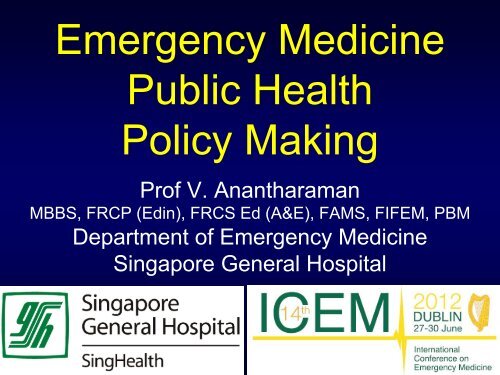Prof V. Anantharaman - MCI
Prof V. Anantharaman - MCI
Prof V. Anantharaman - MCI
You also want an ePaper? Increase the reach of your titles
YUMPU automatically turns print PDFs into web optimized ePapers that Google loves.
Emergency Medicine<br />
Public Health<br />
Policy Making<br />
<strong>Prof</strong> V. <strong>Anantharaman</strong><br />
MBBS, FRCP (Edin), FRCS Ed (A&E), FAMS, FIFEM, PBM<br />
Department of Emergency Medicine<br />
Singapore General Hospital
Clearer understanding<br />
needed of role of ED:<br />
- not just by healthcare administrators<br />
- but also by Emergency Physicians
Role of Emergency Departments<br />
• Receive emergencies<br />
• Resuscitate patients<br />
• Maximize outcomes
Emergency Medicine<br />
Primary Care<br />
P5<br />
Burden of Emergencies in the Community<br />
P4<br />
P3<br />
P2<br />
P1<br />
P1<br />
P2<br />
P3<br />
P4
The Community’s Safety Net ??<br />
• Over reliance on EDs<br />
– Less preventive medicine and chronic disease<br />
management by 1 0 care and civil organisations<br />
• We are the Hospital’s Safety Net<br />
– Why should we also take on the community role?<br />
• Prevention MUST be a central tenet of<br />
community healthcare reform<br />
– Role of civil organisations in prevention
Types of public health interventions at ED<br />
• Provision of preventive interventions in EDs<br />
depends on:<br />
– factors related to disease process<br />
– behavior involved that results in emergency<br />
– underlying complexities of the ED itself.<br />
• Do SBIRT (Screening, Brief Intervention and<br />
Referral to Treatment) interventions constitute<br />
another unfunded mandate for poorly<br />
resourced, underfinanced, crowded EDs ?
Roles of EDs ????<br />
EDs manage acute illness and injury and also:<br />
• successfully provide food and shelter for the homeless<br />
• arrange disposition for elders, pts with substance use<br />
or mental illness<br />
• provide screening for intimate partner violence, HIV<br />
infection, substance abuse, seatbelt and helmet use<br />
• provide vaccinations, when appropriate<br />
• identify chronic medical conditions<br />
• refer patients to primary care providers<br />
for further evaluation and care.
Barriers precluding preventive care in ED<br />
• Incorporating such activities into busy ED setting difficult and<br />
for emergency care providers these services not a priority<br />
• EPs more likely to perform critical resuscitation and diagnose<br />
or exclude life-threatening medical conditions.<br />
• Essential activities are already part of the care EDs provide.<br />
• Numerous resources needed in preventive services delivery.<br />
Availability of local resources will dictate local practice.<br />
• Waiting areas can be stocked with literature addressing<br />
prevention and health education measures<br />
• SBIRT activities are not reimbursable<br />
• Lack of formal training
Stages and Providers of Preventive Service Interventions<br />
Public Health, Prevention, and Emergency Medicine: A Critical Juxtaposition. Steven L Bernstein MD, Jason<br />
S. Haukoos MD, MSc. Academic Emergency Medicine. 2008; 15(2):190–3 .<br />
Stage of ED Visit<br />
Interve<br />
ntion<br />
Triage S X<br />
Triage<br />
Officer<br />
Nu<br />
rse<br />
Physician/<br />
Provider<br />
Ancillary<br />
Provider*<br />
Waiting area S, RT X<br />
History and physical<br />
examination<br />
Post-examination<br />
waiting period<br />
S, BI,<br />
RT<br />
S, BI,<br />
RT<br />
Discharge BI, RT X X<br />
X<br />
X X X X<br />
Supple<br />
mental†<br />
BI = brief intervention; ED = emergency department; S = screening; RT = referral to treatment.<br />
*May include respiratory therapists, phlebotomists, social workers, or others.<br />
†May include brochures and other literature, posters, computerized information, or screening kiosks.<br />
ROUTINE vs EXCEPTION
Issues<br />
• Principal mission of EM is to care for patients with<br />
acute illness and injury<br />
• Community duty of EPs vs right siting of emergency<br />
care and primary care<br />
• Safety net presumes weak primary health care<br />
infrastructure<br />
• Is EM an excuse for a weak primary care system?
Policy Making<br />
• Address need for right-siting of 1 0 care in community<br />
• Ensure community-wide system of 1 0 and 2 0<br />
prevention interwoven into the fabric of society<br />
• Routine 1 0 prevention activities cannot be part of the<br />
ED process of care<br />
• Prevention activities that are part of the process of<br />
management of acute illness and injury are crucial<br />
elements of ED care<br />
• Primary prevention that is not under purview of<br />
primary care e.g. injury control
Conclusion<br />
• Let’s not take on our shoulders the burdens<br />
of the world<br />
• Let’s be focused on our strengths in our care<br />
delivery process<br />
• Strong advocacy needed for communities to<br />
allow primary care medicine to be easily<br />
available and accessible<br />
• Health policies for public health interventions<br />
need to well-tuned for good effect
CHC-based Integrated Emergency<br />
D<br />
I<br />
S<br />
P<br />
O<br />
S<br />
I<br />
T<br />
I<br />
O<br />
N<br />
A<br />
R<br />
E<br />
A<br />
C<br />
H<br />
C<br />
C<br />
O<br />
M<br />
M<br />
U<br />
N<br />
I<br />
C<br />
A<br />
T<br />
I<br />
O<br />
N<br />
S<br />
Response<br />
The Acute Observation Ward<br />
CHC Support Facilities<br />
The Ambulatory Clinic<br />
CHC Specialist<br />
Nurses<br />
CHC Specialist<br />
Doctors<br />
Primary prevention<br />
training materials<br />
Life Skills<br />
Training<br />
facilities
Thank you







